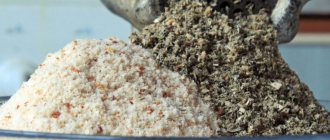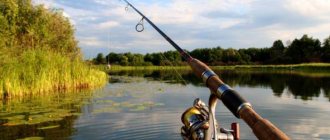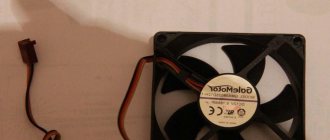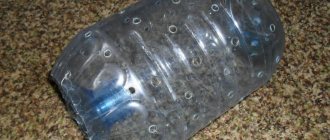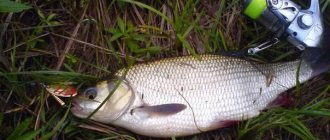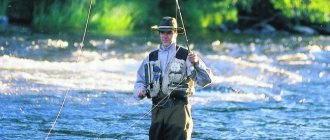Experienced fishermen know about the gastronomic fastidiousness of some fish. Today a fish can literally rush to a crust of bread floating on the surface, but tomorrow it won’t even pay any attention to it. With this in mind, experienced fishermen, when going fishing, always play it safe with several bait options, since you can never say for sure which bait will work best for fish. Fish baits are conventionally divided into two types based on their origin: animal and plant. Bait of animal origin includes various insects, invertebrates, crustaceans, amphibians, and fish. And the list of plant baits includes plant seeds, bread, cereals, various fruits of trees and shrubs, etc. The purpose of this article is to help the reader a little understand this diversity with the choice of bait for fishing.
Standard bait
The most common 4 types of bait are, as mentioned earlier, earthworm, maggot, bread and poppy seed. Some of them are focused on catching non-predatory fish. For example, semolina and bread are ideal for catching crucian carp. Semolina is also well suited for silver carp - it bites on it just fine.
Cooking "Monkey"
Semolina bait can be prepared in two ways. The first of them consists of adding the required portion of cereal in a ratio of 1 tablespoon per serving.
Then it is filled with cold water and kept for 1-2 hours. After time, the finished “solution” must be moved until everything becomes homogeneous. Now the bait is ready. In some cases it is used as bait for fish.
The second method is less common. It consists of the usual preparation of cereals without adding salt. Moreover, it stays on the fire until the porridge is boiled. Which cooking option to choose is a personal matter for each fisherman. One thing we can safely say is that semolina is an excellent bait for fishing, which is easy to prepare and affordable. The only drawback that can be noted is the possible stringiness. That is, a situation is possible when the fish carefully pulls off the bait and the hook remains empty. This happens extremely rarely, but it still happens.
Bread bait
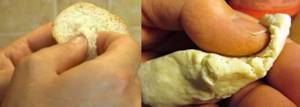
Bread is usually used for bait. It is simply perfect for such purposes. Some fishermen go further and use it as bait. To do this, it is simply soaked in water until it reaches a homogeneous consistency, then molded like dough. As experience shows, in this way you can easily and simply catch many crucian carp, which should be caught well with such bait. The main advantage of bread in this situation: it can be prepared immediately before you start fishing.
Earthworm
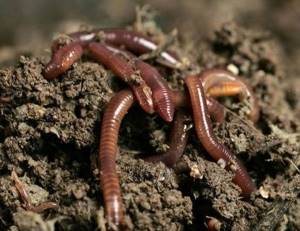
Gudgeon, perch and roach can be caught well with a regular earthworm. Such a bait can be used several times with the right approach. Its main disadvantage is the need to prepare in advance. We must not forget about the proper storage of such bait. With reasonable organization this should not be a problem. You can find them in ravines where it is humid. Another favorite place for them to live is a pile of manure. For these purposes, you will have to travel to the nearest village, find a mountain of manure there and dig up the required number of worms. You can, of course, take the simplest route and buy them on the market.
Getting the worms is only half the battle.
They also need to be kept in proper form until the end of fishing. For these purposes, they are placed in a glass bottle, or in a tin can, or in a plastic container. Any option is suitable. To prevent them from drying out, add a handful of damp soil. As a last resort, you can use a damp cloth (it should be damp, but water should not run off it). Another advantage of such bait is the ability to divide one worm into several parts and thereby achieve greater efficiency from its use. It also cannot be easily removed from the hook and this almost completely eliminates the possibility of the fish being torn off the hook.
Maggots

The last type of bait that is very common is scabs. An ordinary fly larva, not difficult to grow at home, can be stored for quite a long time in a cool place, in the refrigerator. In fishing, they also use tinted maggots with food paint for a brighter color and to increase the interest of the fish. Designed for catching most freshwater fish, it has proven itself very well when added to groundbait.
The previously listed baits for different types of fish do not reflect all the diversity. If you use your imagination, you can find more easily accessible options that can give even more tangible results.
Catching peaceful fish with a spinning rod (for food)
Date: March 17, 2021 | 470
Agree, how much the capabilities of spinning tackle have changed over the past twenty years. New elegant gear, new baits - all this allows you not only to catch traditional predatory fish with a spinning rod, but also to regularly catch completely atypical trophies. These are common fish species for floaters and feeders - crucian carp, carp, carp, bream, tench, roach, rudd, ide, chub, etc. how to catch peaceful fish using spinning rods and artificial baits. It is clear that it is extremely rare to specialize in catching only white fish and peaceful species. But, I will tell you my thoughts on how to increase the frequency of such incidental bites when catching a predator.
Indeed, in light of the progress of spinning gear and baits, more and more often oneself and one’s colleagues are faced with catching peaceful fish using a spinning rod. It happens that fishermen who practice ultralight spinning succeed in this matter. Either with a small spinner or with a mini-wobbler, instead of the expected perch or pike, you come across chub, ide, or even bream, crucian carp... But, of course, edible silicone holds the lead in catching peaceful fish with a spinning rod. Since modern soft baits are the central theme of this blog, I could not ignore this aspect of their use. After all, it’s always nice, after a series of caught fish, to feel at the other end of a thin cord the sedate and powerful pulls of a large peaceful fish.
So, how can you increase the chances of catching peaceful fish when fishing with a microjig or nanojig? There are several aspects to focus on:
— Selecting a reservoir.
— Choice of gear.
— Choice of installation.
— Choice of bait.
— Wiring selection.
In the context of these four factors, I will analyze the possibilities of catching peaceful species of fish with a spinning rod.

Choosing a reservoir . To have a high chance of catching peaceful fish using mikruhu, you should choose a body of water where there is a lot of it. A banal, but very logical and important parting word.
There are reservoirs where exclusively peaceful fish live. Let's say crucian carp, tench, carp, and that's it. There’s not even a perch there... Well, you can conduct experiments on microjig fishing in such ponds. However, it's not very interesting. Because, no matter how hard we try, we will not achieve regular catches of peaceful fish, and the rest of the time we will have to thresh the tackle to no avail. Yes, someone will object that there are also serial catches of crucian carp, carp, and bream for food. I agree, because... I encountered something similar myself. But let's be honest with ourselves. How many such enchanting fishing trips did you have during the season? One, two... It happens that in spring and autumn, when the fish are more active and stay in large schools, it is possible to catch several good tails of peaceful species with a spinning rod for food. But, nevertheless, such fishing cannot be called systematic.
So, I would advise choosing reservoirs where there is a mixed species composition of fish. You will be targeting perch and, at times, pike. And pick up peaceful fish along the way. To increase the chances of such bites, you already need to choose the right baits and their presentation. But more on that below.
Let's finish with the topic of choosing a reservoir. We are interested in lakes and ponds where, at the same time, there are a lot of perch, small pike, and also, in large numbers, perhaps in the overwhelming majority, peaceful fish species are represented. There are many such ponds and lakes - large populations of both predators and peaceful fish (crucian carp, carp, tench, roach, etc.).
As for rivers, there is, as a rule, a richer species composition of fish, both predator and peaceful fish of different species are widely and diversely represented. So, in the current, along with perch, pike, pike perch, you can successfully catch chubs, ides, and bream. And closer to the bays, in sections of the river with a slow flow, there will be chances of catching the same bream, tench, crucian carp, rudd, etc.
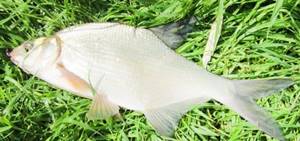
Choice of gear . This is the rule here. To regularly catch peaceful fish using a spinning rod, use the smallest possible baits and the lightest sinker weights. So, the tackle must match. These will be the most elegant microjig spinning rods with small dough.
Installation selection . Peaceful fish are best caught on a microjig with a hinged mount or on spaced rigs. With microjigging, it is best to use the lightest weights possible. You can use miniature jig heads and jigs. But, nevertheless, the hinge, with its freedom of movement, is preferable.
By spaced rigs I mean drop leader and split shot. They, compared to others, are most suitable for catching peaceful fish.
Choice of bait . As a rule, silicone baits for catching peaceful fish are distinguished by their small size. If we are not talking about catching a carp, which can covet even a five-inch creature, then use silicone in sizes ranging from 1” (2.5cm) to 2-2.5” (5-6cm). And, preference is given to narrow, compact baits. Those. According to my observations, bulky baits, such as crustaceans and creatures, do not bring non-standard trophies as often as silicone worms, small slugs, twisters. This does not mean that bulky silicone baits should be abandoned altogether, or that you should not have hopes of catching peaceful fish with them. It’s simple, if you use bait of this type, then choose the smallest crustaceans, about 1.5-2”, no more.
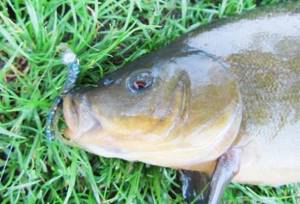
In addition to the size of the silicone bait, the properties of the material are of great importance. It is better to choose silicone that is soft, elastic, richly saturated with attractant and salts. The use of silicone with increased edibility is especially important in the warm season, hot summer. Here the fish are more passive, and the smell of the attractant spreads better in warm water.
It is better to choose dark shades of bait color. Yes, both translucent, light, and bright, acidic ones also catch peaceful fish. But, somehow I noticed, both from my results and from photo reports on the Internet, that whitefish, crucian carp, and other peaceful fish especially prefer dark baits: black, brown, purple, dark green, dark red .
Apparently, peaceful fish see in silicone bait an imitation of their most familiar food - worms, larvae, crustaceans , etc. So, the colors most characteristic of these organisms are suitable. And they are, in fact, mostly dark.
Actually, in the paragraph above, I indicated the main reason why modern silicone edible baits are so good at catching peaceful fish. And, if earlier, before the appearance of such silicone worms, slugs, crustaceans, nymphs, creatures, etc. I caught peaceful fish on a spinning rod “on big holidays,” but with them it’s a completely different calico! We can say that these baits have fully opened up the realm of non-predators for spinning anglers.
Wiring selection . When fishing with an “anchor” in the brain, which would be nice to catch not only a predator, but also hook something of various kinds, then you should use a more sluggish, smooth retrieve, and take longer pauses. This is the best approach to wiring. Passive predatory fish respond better to this type of fishing, and peaceful fish will be caught more often.
I wish all microjiggers to catch large peaceful fish more often, in addition to our usual predators. After all, it’s so interesting when the catch is varied. And modern edible food, with the proper approach that we talked about here, allows you to achieve this.
Share with your friends:
Categories: Fishing for edibles · Tags: Microjig, Nanojig, Lures, Edible, Technique
Bait based on experience
Experienced fishermen know that any fish bites well on insects. These include flies, caterpillars, larvae, butterflies, and grasshoppers. Any of them will be an excellent bait with which you can catch almost any fish. Their main advantage is the possibility of fishing on the way to fishing or just before it starts. Any clearing, grove or bush is a place where you can find many different insects and catch them. Such bait does not require complex preparation. It is enough to cut it up (divide it into parts, if it is large, and if it is small, then you can simply put it on a hook) and start fishing. It bites excellently, both carnivorous and non-predatory fish. Overall, insects are a great solution that requires no special preparation and is easily accessible.
Snails and clams can be used in a similar way. But here everything is not so simple, since the question arises: “How to make bait for fish from such spineless ones?” The answer is very simple. The shell needs to be destroyed or opened.
The situation with sea mussels is simplest. Just put them in a hot frying pan and they will open on their own. But with snails it is much more difficult. Their shell must be destroyed. For these purposes, you need to take a hammer or stone when fishing. This type of bait is not used very often, since it is not always possible to catch mussels or collect snails.
But one thing is certain – using them for fishing is very profitable. Especially if you plan to catch a goby - it bites perfectly on any type of similar bait.
Fast and efficient
Sensas fragrance spray is produced in France. Small 75 ml bottles contain liquid intended for each type of fish separately.
Each of them has its own scent. Flavorings for carp, crucian carp and other large fish smell like fishmeal, roach and bream will like earthworms, and barbel will fall for the aroma of cheese.
But there is a universal option - Sensas Bombix Brasem. It is suitable for many types of predatory fish.
Fishermen speak positively about the sprays from this manufacturer. But they advise you to experiment with smells.
And here's what you need to know: Fishing calendar for 2021 by months and days
There have been cases when a scent intended for one type of fish stimulated the bite of another.
Predator bait
Now we will try to figure out what bait to use to catch fish from a predator in freshwater bodies, for example in a lake. There can only be one answer - cancer. Its meat is an excellent bait with which you can catch large predators (pike, for example). And catfish bite well too.
Before fishing, they try to catch the required number of crayfish. There are no problems with this, you just need to look well in the nearby reeds. Then you need to cut them up and select the meat, cut it into small pieces and pack it. Before you start fishing, you need to lower it into the water on a hook in order for it to harden. This procedure lasts a maximum of half a minute, after which the hook is cast and you can start fishing.
Leech
Another type of bait that is not widely used, but is very effective, is the leech.
It is best to use them in this role in the spring. At this time of year, it behaves actively; the constantly changing water level greatly simplifies the process of catching it. The largest number of leeches gather in quiet river bays, where ideal conditions have been created for their life. It is excellent for bream, roach and perch. The best bite for such bait is observed either in the morning or at night. This can be explained very simply: at night and in the morning the leech goes out to hunt, but at the same time it itself often becomes prey for fish.
Fish bait is an important part of any successful fishing trip. The result depends on the correctness of its choice.
The choice is made based on what is found in the pond, river or sea. For example, it is good to catch a goby using an earthworm or mussel. But for crucian carp, semolina or soaked bread is better. Taking into account these not very complicated features, you can achieve quite tangible results and get a truly fantastic catch that will delight your fellow fishermen.





